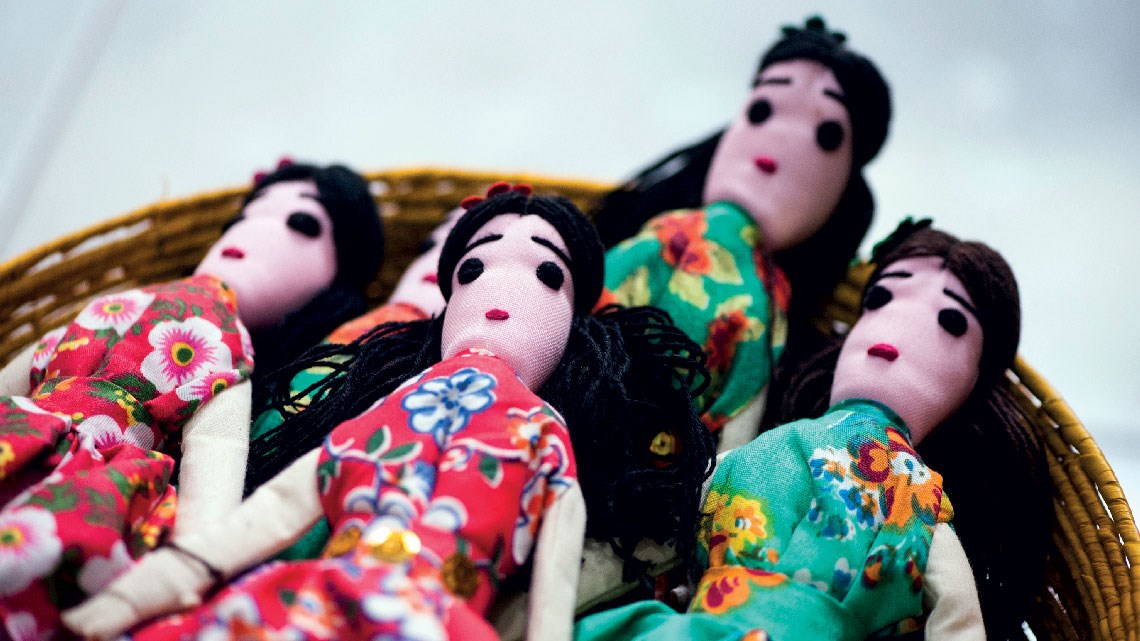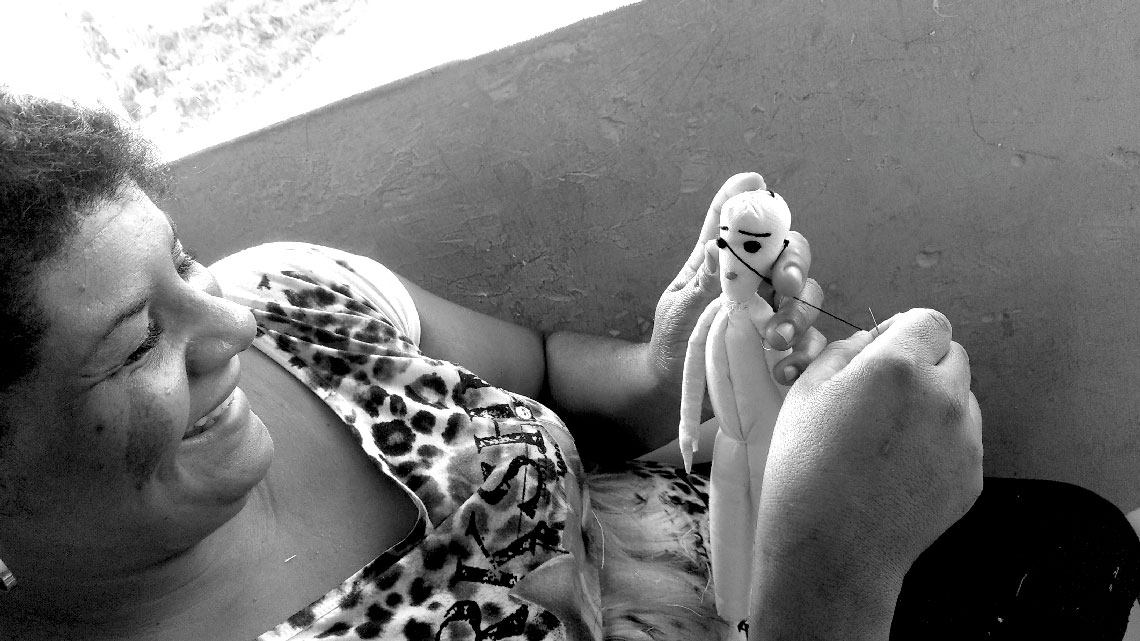
In 2011, a replica of the sapphire and diamond ring Kate Middleton wore on her wedding day became a best seller in low-end high street stores in Brazil’s southeastern city of São PauloPhilippe Lopez/AFP Hilippe Lopez / AFP
Each year, dozens of cruise ships sail from the Caribbean and the southern US coast to the mouth of the Amazon River, carrying aboard American and European tourists keen to enjoy the beauty of the Amazon from the luxury of a cruise ship with amenities such as heated pools, restaurants with sophisticated cuisine, and cabins with personalized services. In an area of Parintins known as Boca da Valéria, passengers visit riverside communities on the banks of the Amazon, where they have the opportunity to hike into the jungle, purchase bead necklaces produced by artisans, and take pictures with baby alligators, in exchange for a few dollars. Their patronage ends there—foreigners are cautioned, just before disembarking, not to buy food or beverages from the locals to avoid food poising. They return to the vessel hours later, as the river dwellers await the next cruise ship.
Behind this form of tourism are luxury cruise companies that lure millionaire tourists by painting an exotic and picturesque image of the Amazon and its people. “They benefit from environmental resources and port infrastructure without generating significant economic and social benefits for local communities,” says geographer and environmental consultant Thaís Zucheto de Menezes, who explored the subject in a master’s thesis at the School of Philosophy, Languages and Literature, and Humanities at the University of São Paulo (FFLCH-USP). Her findings from analyzing the activities and interaction of six foreign-based companies and state and municipal tourism authorities in the region raised concerns.
“In general, tourism departments are highly welcoming of cruise-ship tourism as a source of income opportunities and tax revenues that can be used toward improving infrastructure,” says Menezes. But her study found that the picture is not as rosy as it may seem. “In many cases, tourism departments are subordinate to the cruise-ship companies.” In river harbors in Amazonas and Pará, for example, Menezes found that visitors are not required to pay port charges as they are elsewhere in Brazil. The only payments tourists make are to local travel agencies offering sightseeing packages in the cities where the cruise ships call, such as Santarém and Belém. “In addition, river terminal infrastructure is not equally available to users. Regional boats are required to berth at more rudimentary platforms than those available exclusively to luxury cruise ships.” Asked to comment, the Pará State Department of Tourism said the costs of disembarking passengers are borne by the shipowners, but confirmed there were in fact plans to build exclusive river terminals for cruise ships. “The government has commissioned studies toward building special terminals to accommodate international ships in Santarém and Belém, as a way to increase tourism in the region,” says André Dias, the state’s secretary of tourism.
“Like contemporary art, luxury is at once universal and restricted,” says Ortiz
Ships traveling through the Amazon are just one facet of the global market for luxury goods and services, an industry worth US$1.4 trillion in 2019, a figure 4% higher than in the previous year, according to a Bain & Company report. The segment is unique in its consistent growth even in periods of global economic turbulence, says sociologist Renato Ortiz of the University of Campinas (UNICAMP). “The luxury market has enormous economic power and, perhaps because of this, is weakly regulated,” he says. “There is much that is unknown about the sector, including the companies operating in it,” says Ortiz, who compiled data from private consultancies, business newspapers, and trade journals to write the book O universo do luxo (The universe of luxury; Alameda, 2019).
The book explores the universe of luxury brands like Dior, Louis Vuitton, and Rolex, providing insight into little-known aspects, such as the recent emergence of a transnational elite that is adopting new ways of distinguishing itself from society. “Like contemporary art, luxury is at once universal and restricted,” notes Ortiz. “Designer clothing from the French fashion brand Chanel can be found all around the world, but most people can’t afford it.” Rare wines, private jets, jewelry and, yes, luxury cruises, are goods and services that are detached from their local roots to become symbols of status and “good taste,” says Ortiz.
For the sociologist, the way of life of the wealthy and affluent should not be overlooked by the social sciences, especially by researchers seeking to unravel the inner workings of power relations in contemporary society. Research fields such as sociology and anthropology have only recently begun to direct greater attention to the consumption habits of the elites. “Scientists’ interest has always been focused on the poorest classes, who are the ones who suffer most from unemployment and low income. The dominant elites are generally studied from a political rather than a cultural perspective,” explains Ortiz. A critical investigation of consumption and living standards among the wealthy can provide important clues to understanding why social inequality and income concentration continue to increase. “Spending thousands of dollars on a night at a luxury hotel in French Polynesia epitomizes the mindset of the high-net-worth consumer, who prizes everything that is exclusive and made for an elite few,” he says.
Even articles sold at craft fairs in the Northeast can become an object of desire in the luxury market—so long as they have passed through the hands of a prestigious designer. This phenomenon was explored in a master’s dissertation by designer Viviane Mattos Nicoletti at the USP School of Architecture and Urbanism (FAU-USP). “For example, artisans often supply wooden furniture to famous designers, who then adapt them to the taste of the luxury market and sell them for a fortune at high-end stores in major cities,” says Nicoletti, a professor at Instituto Europeo di Design and Universidade São Judas, in São Paulo. She analyzed this practice in three artisan communities in northeastern Brazil: one on the banks of the São Francisco River, in Alagoas, where artisans make wooden furniture and sculptures; one in Riacho Fundo, Paraíba, where women artisans make traditional rag dolls for a living; and the third in Várzea Queimada, Piauí, where a local group produces straw baskets.
The rag dolls, known locally as “little witches” (bruxinhas), are made of scrap cloth and are very popular in the Northeast. In 2002, a Brazilian design office with a strong presence in Europe used rag dolls made in Riacho Fundo to design a limited series of 35 armchairs. “They were sold in international art galleries and can still be found in auctions today,” says Nicoletti. “The dolls soon gained iconic status among traditional handicraft aficionados, and stores in Europe and the US began to order dolls directly from the artisan community.” The design office and its European representative were not happy, and decided to amend the partnership agreement with the artisans to secure an exclusive right to sell, and copyright in, the traditional dolls. Under the advice of a lawyer, the artisans refused the proposal, and the office decided to terminate the agreement. With the loss of financial support, they were unable to resume their original production arrangement. “Through their agents, players in the luxury market attempt to monopolize the sale of handcrafted articles when their meanings and narratives are incorporated in the design of their products,” says Nicoletti. “And there are no measures taken in the supply chain to protect artisans’ autonomy so they can decide how their products are marketed, including directly to end consumers. The current situation is one of subservience.”
Appropriation, a core element of the luxury market, is also seen in the high-end real estate market. In a study in São Paulo City, urban planner Raquel Rolnik, of FAU-USP, found that the luxury segment had grown 13% in 2017, while overall property sales in the city had fallen 4.5% in the same period. As with luxury cruises, which have exclusive docking infrastructure in the Amazon, spatial segregation is a lucrative business in major cities in southeastern Brazil. “The growth in sales and in the value of luxury or superprime properties, as they are known, obviously has little to do with higher demand for housing,” says Rolnik. “These expensive properties are a form of investment or wealth preservation, typically done in a globalized manner.”
Ultra-expensive real estate represents an effective way to invest surplus capital in the medium and long term, explains Rolnik. “These properties increase in value over time, allowing the upper classes to amass even more wealth,” says Rolnik, noting, for example, how thousands of houses and flats in upscale districts of London are currently vacant, even as the broader city is experiencing a serious housing shortage. One consequence of this in places like São Paulo, explains Rolnik, is that lower-class residents must compete with millionaires for urban space. “Huge swathes of the city are now occupied by vacant properties. And this is true not only in the city’s central districts. On the outskirts, luxury gated communities are already competing with housing projects for available land,” she says.
 Léo Ramos Chaves
Léo Ramos Chaves
In this segment, he explains, luxury is cascaded down to expand markets and influence consumption patterns, such as by encouraging consumers to occasionally “indulge” themselves with something expensive. Borrowing on French philosopher Giles Lipovetsky’s concept of democratizing luxury, Silva explains that it is not about making luxury more widely accessible, but about giving people a taste owning the inaccessible. “Some brands launch products that are slightly more affordable and can be purchased, with not a little sacrifice, by the middle class. People can get a taste of owning a wallet or belt from a famous designer brand without having to purchase the brand’s more expensive items.”
This strategy aims, says Silva, to increase the brand’s perceived value by making its products something desired by many, but had by few. This advertising technique is also designed to “educate” future millionaires, making them potential buyers of luxury items. The Brazilian tradition of paying for purchases in installments, even among the more affluent, led French brand Louis Vuitton to accept installment payments on an exceptional basis in Brazil. “Here and nowhere else you can purchase a Louis Vuitton handbag worth several thousands of dollars and pay for it in 10 installments,” says Silva.

Luxury travel guides entice tourists with exotic and picturesque images of the AmazonPallava Bagla / Corbis / Getty Images
Efforts to develop new consumers have been especially effective in China, where the luxury market grew by about 26% in 2019, reaching €30 billion, according to a survey by Italian association Altagamma. China accounts for a constantly growing share of the market for cars, arts, fine dining, luxury hotels, and rare wines. Asians overall form a majority of global consumers of luxury goods—approximately 51%. “In recent years, the rapid rise of the Chinese middle class has led to increased contact with Western consumption habits. Millions of Chinese have traveled to Europe and the US, where they have been introduced to high-end brands. The same is true of the country’s new rich,” says Silva.
In recent years, attracted by cheap labor and the expanding market, many brands have opened factories and stores in continental China. The recent outbreak of the novel coronavirus, however, has taken a toll on the sector. A Forbes survey in February found that, in less than three months, 150 of the 250 stores that Capri Holdings—the owners of brands like Versace and Michael Kors—had opened in China have now been closed indefinitely. US-based Ralph Lauren has shut half of its 115 stores in China, while German brand Adidas has announced a “temporary closure” of a considerable number of its 12,000 points of sale in the country.
Republish